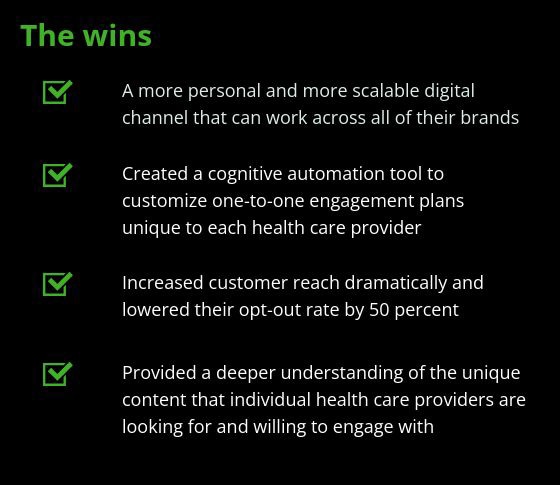Cloud case studies
Creating personalized relationships with email in health care
Large pharmaceutical company reduces opt-out rate by 50 percent
Deloitte helped a large pharmaceutical company analyze five years of data across 700,000 health care providers with the use of cognitive tools, increasing customer reach.

What if you could develop one-to-one relationships with thousands of your customers? You would know what they do, what they need, and how they want to be reached. You could be able to increase digital engagement like e-mail opens, clicks, and opt-ins while lowering opt-out rates and helping customers get things done, giving them a better experience, and making them happy.
That's exactly what a pharmaceutical manufacturer achieved with cognitive insights and engagement. Using machine learning, the company was able to get a deep understanding of prescribers' unique needs and preferences when it came to digital communications. They were able to get personal using digital, which usually doesn't happen at scale.
A pharmaceutical company was sending health care providers hundreds, and in some cases, thousands of e-mails each year from dozens of brands, some that weren't relevant to their practice. These digital promotions were driving disengagement, opt out, and negatively affecting customer experience.
"Using machine learning, the company was able to get a deep understanding of prescribers' unique needs and preferences when it came to digital communications."
Creating personalized relationships while reducing opt-out rates by 50 percent
What happened next
The client engaged Deloitte to help them analyze five years' worth of data with 700,000 health care providers across dozens of brands all within ten weeks. This led to a deeper understanding of the unique content that individual health care providers are looking for and will engage with as well as the ideal times, frequency, preferred content, and format to reach them.
The client built a cognitive automation tool to customize one-to-one engagement plans unique to each health care provider so they would only receive the content they want when and where they want it. This helped the client increase customer reach dramatically and lower their opt-out rate by 50 percent.

By making the customer the center of both the digital and real-life relationship, the company now has a more personal and more scalable digital channel that can work across all of their brands. This new marketing capability has also helped the business evolve their marketing strategy, get an omni channel view, and drive dynamic messaging to their customers.
By the numbers
50% decrease in customer email opt-out rate
700,000 health care providers data from the past five years was analyzed across dozens of brands within ten weeks




